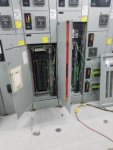JRumsey
Member
- Location
- Beaumont, Texas, USA


Above is a panel to be installed in a PDC (Power Distribution Center or Power House). This panel came with three separate ground bars; but with only one ground bar having a grounding electrode connection point. The two ground bars that do not have a grounding electrode point are screwed directly to the panel. Should these two ground bars be jumpered to the third ground bar or can the panel be used as the connection between these three ground bars?
Also, is there any educational literature or videos that deal with grounding that I could use as a training tool?

